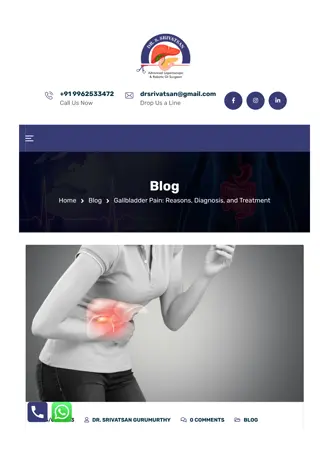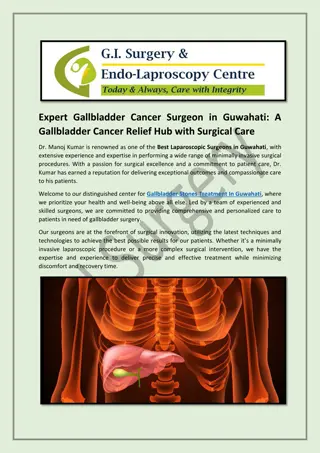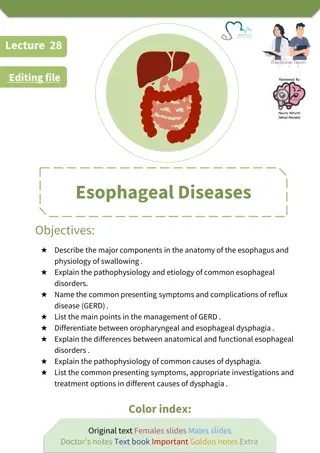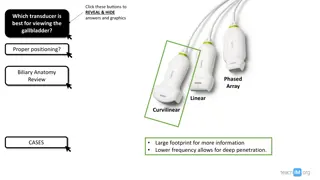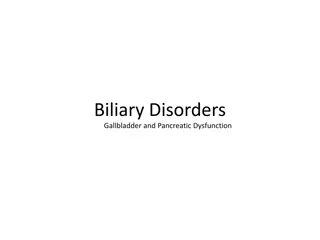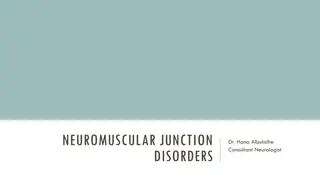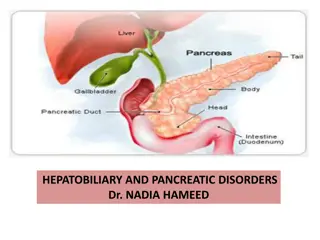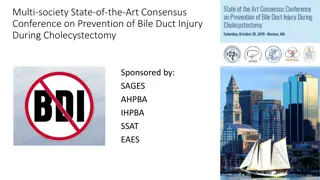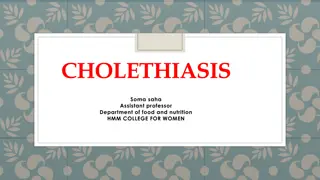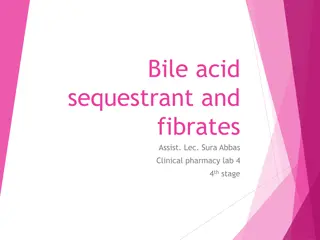Understanding the Anatomy, Physiology, and Disorders of the Gallbladder and Bile Duct
The gallbladder and bile duct anatomy includes details on shape, length, capacity, blood supply, lymphatics, physiology, bile production, functions, investigations, congenital abnormalities, types of obstructions, clinical features, differential diagnosis, and treatment options including surgery and complications.
Download Presentation

Please find below an Image/Link to download the presentation.
The content on the website is provided AS IS for your information and personal use only. It may not be sold, licensed, or shared on other websites without obtaining consent from the author. Download presentation by click this link. If you encounter any issues during the download, it is possible that the publisher has removed the file from their server.
E N D
Presentation Transcript
The gall bladder and bile duct : Anatomy: -Pear shape , 7.5 12 cm in length . - Capacity > 50 ml . - Fundus , body , neck & infundibulum . - cystic duct ( 2.5 cm , 0,5 cm ) join common hepatic duct ( 2.5 cm ) to form CBD. ( 7.5 cm ) Blood supply : cystic artery from Rt. Hepatic artery . Caterpillar turn : Tortuous Rt. Hepatic artery in front of origin of cystic duct with short cystic Ar. Lymphatics : two ways ; 1- To cystic L.node of lund coeliac L. N. 2- Directly to liver . Physiology : Bile 97% water 2% bile salt 1% bile acid and cholesterol.
Bile production : Gall bladder function : 1- Reservoir & storage. 2- Concentration of bile 5-10 times . 3- secretion of mucin ; 20 ml / day . Bile production : 40 ml / hour = 1000 ml /day . Gall bladder function : Investigations of biliary tract : 1) Plain Xray : - Radio opaque stone 10 20 %. - Porcelain gall bladder . - Limey bile . - Gas in biliary tree. 2) Oral cholecystography & iv. Cholangiography. - Out of use . - Historical interest. 3) Ultrasonography : - Prime test . - Standard test . - Quick , non-invassive test . 4) ERCP. & endoscopic ultrasonography . 5) PTC . Investigations of biliary tract : 6) MRCP (standard, no contrast).
7) Radio isotope scanning : 99mTC labelled HIDA , IODIDA . Iv. given , excreted in bile, gall bladder visualised 30 minute if delayed to 1 hour suggest acute cholangitis or contracted gall bladder ( chronic ) . 8) CT. Scan : -To detect liver and pancreatic lesion . - Cancer extent and staging . - L. Node enlargement . 9) Per operative cholangiography . 10) Per operative choledochoscopy : Flexible fibreoptic endoscope to localize and extract stone .
Congenital abnormalities of GB. & bile ducts : 1- Abscence of G.B. 2- Phryngian cap 2 6 % , phrygian cap like hats of people of phrygia (asia Minor). Suptum in G. bladder either complete or incomplete . 3- Intra hepatic G.B. 4- Floating G.B. torsion . 5- Double G.B 6- Cystic duct anomalies : Intra hepatic ; -Accessory duct . - Low insertion . - Short or absent. Extra hepatic biliary Atresia : -1/14000 live births . - Occlusion of variable length . - inflamation destruction fibrosis obliteration . Out come : -Biliary cirrhosis . - Portal hypertension . - Jaundice . - Liver failure
Types : Type I occlusion of C.B.D. Type II C.B.D. + C.H.D. Type III C.B.D. + C.H.D. + Lt. & Rt. H.d. Clinical features : 1- Jaundice at birth progressive 2- Pale muconium. 3- Dark urine . 4- Steatorrhoea leading to Osteomalacia( biliary rickets ). 5- Clubbing of fingers . 6- Portal hypertension . 7- Another anomalies in 20% . DDx: 1- Neonatal jaundice . 2- Choledochal cyst . 3- Inspissated bile syndrome . 4- Neonatal hepatitis. Rx : Early surgery Roux-en-Y or liver transplant. Post op. Complications : 1- Cholangitis in 40% . 2- Portal hypertension 50% .
Choledochal cyst : Def.: Congenital cystic dilatation of biliary tract (particularly CBD). Clinical features : 1- Jaundice . 2- Rt. hypochondrial cystic mass . 3- Cholangitis & pancreatitis . Dx : 1- ultrasound diagnostic test . 2- MRCP. Px :Premalignant cholangiocarcinoma . Rx : Surgical excesion & Roux-en-Y .
Gall Stone Mixed stone Features Features Cholesterol stone Cholesterol stone Mixed stone Black Pigment S. Black Pigment S. Brown pigment S. Brown pigment S. Epidemiology Female, Fatty, Fertile, Forty pure cholesterol) location Components location Components Gall bladder Hardened cholesterol (almost Gall bladder Mostly cholesterol (51-99% of stone contents) + calcium salts, bile acids, bilirubin pigments & phospholipid Gall bladder Mostly Bilirubin pigments+ Ca phosphate+ Ca carbonate+ 30% cholestrol Bile Duct Mainly Ca bilirubinate+Ca palmitate+ Ca stearate + 30% cholestrol Types 1. Cholesterol and 2. Mixed : 80% in US and Europe 3.Pigmented: 80% in Asia common possible Aetiology Small, hard, multiple, faceted, green or yellow Small, black, irregular& multiple Gross Features Gross Features Large solitary, white Large, brown & single common possible Aetiology Most common Cases in which chol increase or bile acid dec in bile associated with patients with obesity, high caloric diet, contraceptive pills, ileal resection, abnormal emptying of gall bladder Highly associated with SCA, H spherocytosis& cirrhosis Associated with bile stasis & infected bile due to FB in bile duct like stent or parasitic infestations like Chlonorichis sinensis or Ascaris lumbricoidis Same as mixed Aetiology 1. Metabolic 2. Stasis 3. Pregnancy 4. Infection H. pylori 5. Others .Sickle Cell Anaemia . Heriditry Spherocytosis World distribution cholesterol or mixed around 10% of them is pure Cholestrol stone In US and Europe 80% In US and Europe 80% cholesterol or mixed .. Around 70% of them is mixed stone In US and Europe, both types of pigment stones represent around 20% of total mostly in immigrant people from Asia and Africa. In Asia 80% of . stones are pigment stones (black more than brown In US and Europe, both types of pigment stones represent around 20% of total mostly in immigrant people from Asia and Africa Common in Asia. In Asia 80% of stones are pigment stones.(black more than brown) World distribution (See the diagram below).




